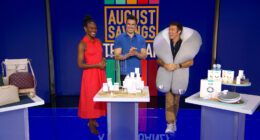A quick 30-second fitness test can be an indicator of how long you’ll live, according to a new study linking mobility and mortality.
The study from the European Journal of Preventive Cardiology looked at how well men and women could go from a standing position to sitting on the floor before standing back up again, without using their hands, knees, other people or furniture.
The exercise, called the Sitting-Rising test, scored 4282 men and women between 46 and 75, giving them a final score between 0 to 10 based on their ability to sit and stand.

Those with lower scores were found to have higher mortality rates.
Middle-aged and older people who needed no support to sit or stand were six times less likely to die of heart disease and cardiovascular conditions over the next decade compared to people who wobbled on the way up or down, and had difficulty completing the task.
Test yourself with a partner
Author of the study Claudio Gil Araújo warned not to do this test alone.
Anyone with a disability, like a hip or spine injury, or anyone with serious joint problems, shouldn’t do the test, as it can cause unnecessary pain.
Get another person to watch you and score your sitting and standing movements by following the Sitting-Rising Test (SRT) system:
- Place a cushion under you to avoid injuries if you fall.
- The test begins with 5 points for the sitting action and 5 points for the rising action, totalling 10 points.
- Start with 5 points for the sitting action. Try to lower yourself by crossing one foot in front of the other, and lower yourself.
- One point is subtracted for each support used, such as a hand, forearm or knee.
- If one hand is placed on the knee for support, it counts as a support; deduct one point.
- Half a point (0.5) is subtracted if the action is as unsteady, indicating a partial loss of balance.
- A score of 0 is given if the person is not able to sit from the floor without external assistance (like using a table or wall to sit and stand, or with another person’s help).
- Once on the floor, begin the standing action. Start with another 5 points.
- Score the standing action in the same way, deduct a point for using a support and half a point (0.5) for a wobble.
- Score a 0 if they are unable to stand without external help.
- The final score is obtained by adding the sitting and rising partial scores, resulting in a total score ranging from 0 to 10.
The test is supposed to measure a range of health aspects, such as muscular health, balance, flexibility and body composition.

What does my score mean?
Based on the study, your SRT score provides an indication of your non-aerobic physical fitness. This is linked to your risk of natural death and death caused by cardiovascular disease/illness.
SRT Score of 10 (Perfect Score):
- A perfect score indicates excellent non-aerobic fitness, including muscle strength, flexibility and balance.
- A score of 10 is associated with the lowest risk of natural mortality, with a death rate of 3.7 per cent.
- Those with a perfect score had a cardiovascular death rate of 0.9 per cent.
- Survival rates in this group after a decade were at 97 per cent.
- Higher scores are also related to easier performance of daily activities, increased participation in physical activity, exercise, and sports, and potentially a better overall quality of life
- A score of 8 typically means you used only one hand or knee for support to sit and rise from the floor
- The natural causes death rate for this group was 11.1 per cent, which is triple the rate of those who scored a perfect 10.
- Survival rates after a decade were at 88 per cent for this group.
- A score between 4.5 and 7.5 was associated with an increased risk of premature death
- People in this group had a 2.23 times increased risk of natural death compared to those with a score of 10
- People in this group had a 3.25 times increased risk of cardiovascular deaths compared to those with a score of 10
- The death rate for natural causes in this group was 20.4 per cent.

SRT Scores of 0-4 (Lowest Scores):
- Scores between 0 to 4 indicate poor non-aerobic fitness.
- These scores were associated with a significantly higher risk of natural and cardiovascular deaths.
- People in this group had a 3.48 times higher risk of natural death compared to those with a score of 10.
- People in this group had a 6.05 times higher risk of cardiovascular death compared to those with a score of 10.
- The death rate for natural causes was 42.1 per cent.
- Survival rates in this group after a decade were 73.
- These scores often present with an unhealthy combination of excess body fat, dynapenia (muscle weakness), reduced body flexibility, and poor static balance. This could increase the risk of falls and limit daily activities and exercise, adversely impacting survival
- Specifically indicates an inability to rise alone from the floor. .
- Nearly half (49.5%) of the participants with this score died during the follow-up period of 10 years.
- People with this score showed a five to six times higher risk of natural deaths and cardiovascular deaths compared to those with a rising score of 5.
A higher SRT score reflects better physical fitness and is linked to a significantly lower risk of death from natural and cardiovascular causes.
Lower scores indicate poorer non-aerobic fitness and a substantially elevated mortality risk.
Please note the information in this story is general in nature. Please always consult your GP or health professional for advice that is tailored to your specific health concerns.






